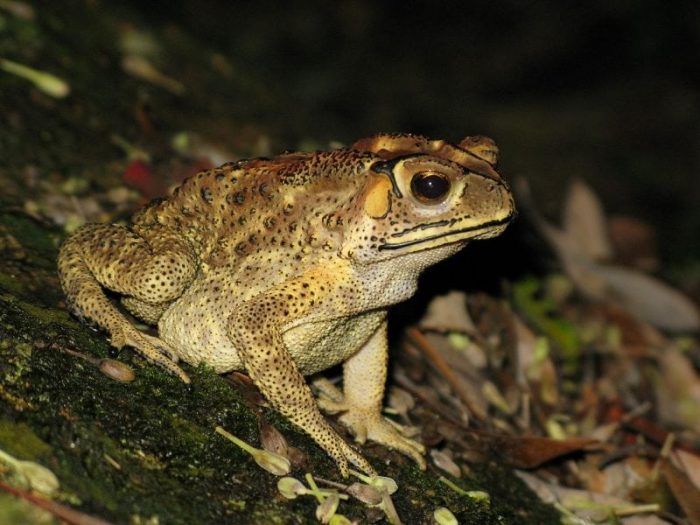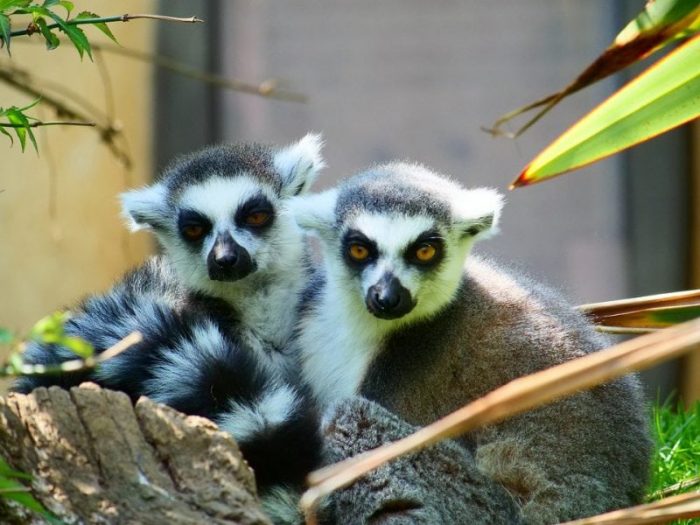
The Asian common toad was originally found on Madagascar at a large seaport back in 2014. At the time, conservation groups warned that the invading toad could have harmful effects on animal populations in Madagascar, much of which is unique to the African island. In a recent survey of the island’s fauna, scientists have confirmed that the toad’s slime will probably kill almost anything on the island that tries to eat it.
Toxins And Adaptations
The Asian common toad (Duttaphrynus melanostictus) defends itself from predators with an extremely deadly toxin, which it secretes through pores in its skin. True toads (not frogs often referred to as toads) are of the family Bufonidae. They also create toxic proteins from large glands called parotoid glands, which are found on their backs. The “bufotoxins” function by impacting a cell’s ability to regulate levels of potassium and sodium, quickly leading to heart failure and death.
Nonetheless, some rodents and snakes have evolved to be able to eat the toad, thanks to mutations that nullify the deadly toxin. According to Wolfgang Wüster, a herpetologist from Bangor University, United Kingdom, since Madagascar has been a relatively isolated island for the past 80 to 90 million years, it has never had poisonous toads. Therefore, the fauna of the island – including the unique species of birds and leaders found there – could be devastated by the toad, since they never evolved the ability to nullify the toxin.

Photo: Lokionly via Wikimedia Commons, CC-BY-SA 3.0
Wüster and the rest of the research team conducted an extensive investigation of the island’s animals, to see if they contained similar mutations to that would protect them from the toad’s toxicity. The researchers analyzed the DNA of 88 different species of animals and discovered that there is only one species (of the animals they surveyed) capable of eating the toad without dying, a rodent referred to as the white-tailed antsangy. Research into the mechanism behind the resistance to bufotoxins has revealed that some animals have the ability to substitute two amino acids found in bufotoxin, rendering it harmless. In areas where toads are natural, many different species of lizards, rats, and snakes have evolved this ability. The antsangy apparently has the ability as well.
The other animals whose genes were analyzed include two frog species, two species of lizards, 27 different snakes, eight mammals, and 28 birds that could possibly feed on the Asian common toad. The other predators on the island lack the mutations which would give them resistance to the toad’s slime, meaning that the wide variety of rodents, snakes, lizards, and lemurs which might eat the toad could easily be harmed by the toads toxins. Worryingly, Wüster explains that small amphibians like the common Asian toad are easy prey for most large animals on the island, and that “there aren’t many things that wouldn’t eat them.”
Nicholas Caswell, co-author of the study, says that the study confirms what conservationists have feared:
“Our findings confirm that the invasive toads are likely to have a significant impact on many Malagasy endemic species, adding to the country’s existing conservation problems and potentially endangering many of Madagascar’s most iconic endemic species, such as tenrecs and the enigmatic fossa, as well as a plethora of other species.”
A Devastating Invasion
The toads have not yet invaded into the predatory range of most species on the island just yet, currently they’ve only been seen along an approximately 350 km long strip of coast on the northeastern part of the island. However, conservationists say that their range is expanding quite rapidly, threatening to move into areas with populations of vulnerable animals. The toads can breed very quickly, with one female being able to produce thousands of offspring. Madagascar is home to many different waterways and rice paddies, which they can use to breed and expand.
Wüster explains that deforestation has already threatened many of the island’s indigenous animals, with many species native to the island struggling to live on in only small swaths of remaining habitat. The Asian toad invasion could be the thing that “knocks them over the edge”.

Photo: By TimVickers – Own work, Public Domain, https://commons.wikimedia.org/w/index.php?curid=4578169
Herpetologist from the University of Michigan, Ann Arbor, Fred Kraus explains that the common Asian toad is one of the most prolific species of invasive toads in the world. The other is the cane toad, which has taken over large parts of Australia. Kraus says that he doesn’t “see anything stopping it. … At this point, you’d need millions and millions of dollars.”
Nonetheless, conservationists like Guinevere Wogan, an evolutionary biologist from the University of California, Berkeley, (who wasn’t involved with the study) haven’t given up hope in combating the invasion of the toad. Wogan explains that knowing how many species are at risk from the toad is a critical step towards determining how to tackle the invasion and save what diverse life can be saved.
Containing An Invasive Species?
The invasion of the Cane Toad in Australia proved to be detrimental to native species on the island. The toad was introduced to Australia back in the 1930s, and there are now more than 200 million of the toads found on the continent. The toads have poisoned pets, humans, and native fauna like quolls, snakes, monitor lizards, and goannas. They have also reduced the amount of food available for Australia’s native insectivores like skinks. Wuster says that similar effects are likely to happen in Madagascar as well.

Photo: Kdsphotos via Pixabay, CC0
Anecdotal reports are already suggesting that native snakes may be dying due to consuming the toads, and in the past, die-offs of native snake populations have lead to explosions in rat populations and public health concerns. Non-native rats on the island are resistant to Bufotoxins, compounding the problem. The carnivores of Madagascar, particularly the fossa are likely to encounter and eat the Asian toad. Lemurs mainly eat plants and insects, only occasionally preying on small vertebrates, meaning that the toad may have a limited effect on them.
While animals in Australia have proven surprisingly adaptable to cane toad, learning to only eat the least toxic parts of it, or avoid it altogether, it wouldn’t be prudent to rely on the adaptability of animals alones if we are worried about the conservation status of animals on Madagascar. It can be extremely difficult to contain an invasive species, though there are various methods that can be used including hunting and forms of biological control. There have been various attempts to control the spread of the toads, though initial attempts to contain the toads have failed. Wüster and colleagues hope that efforts to eliminate the threats posed by the toad will be reinvigorated by the study.









